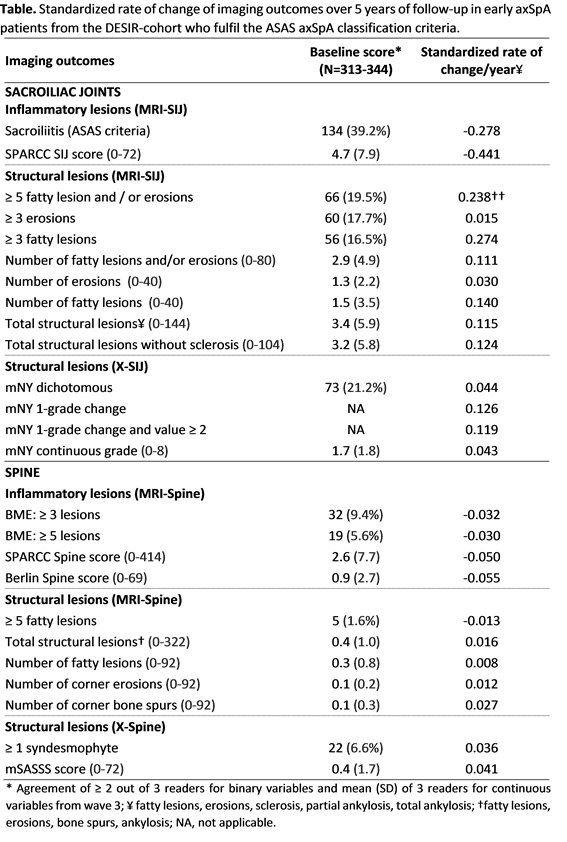Session Information
Date: Sunday, November 5, 2017
Title: Spondyloarthropathies and Psoriatic Arthritis – Clinical Aspects and Treatment Poster I
Session Type: ACR Poster Session A
Session Time: 9:00AM-11:00AM
Background/Purpose: Several imaging outcomes have become available to assess inflammation and structural damage over time in patients with axial spondyloarthris (axSpA). However, no formal comparison of their sensitivity to change has been made in the early phases of the disease. We aimed to compare the sensitivity to change of different MRI and radiographic scoring methods in patients with early axSpA.
Methods: Patients from the DESIR cohort fulfilling the ASAS axSpA criteria were included. Radiographs and MRI of the sacroiliac joints and spine were obtained at baseline, 1 year, 2 years and 5 years. Each film was scored by 2 or 3 readers in 3 ‘reading-waves’ (wave 1: baseline; wave 2: baseline, 1 year, 2 years; wave 3: baseline, 2 years, 5 years). Outcomes measuring inflammation and structural damage both on MRI and radiographs in the spine and SIJ were assessed (Table). The analysis of change captured over time was performed using generalized estimating equations (GEE) longitudinal models separately for each outcome, taking into account data from all readers and waves (‘integrated analysis’). To allow comparisons across outcomes, these were standardized (difference between the individual score and the mean of all scores divided by the standard deviation, per reader, wave and time-point) before running the models. The higher the standardized coefficient the more change in inflammation/damage is captured.
Results: In total, 345 patients were included (mean (SD) symptom duration: 1.6 (0.9) years; 53% males; 89% HLA-B27 positive). Inflammation on MRI-SIJ (according to both the ASAS definition of sacroiliitis and the continuous SPARCC score) was more sensitive to change as compared to inflammation on the spine that remained essentially unchanged regardless of the outcome (table). Structural damage on the SIJ was found to increase over time, but with a higher standardized yearly rate of change on MRI-SIJ (range: 0.015-0.274) as compared to X-SIJ (range: 0.043-0.126). Notably, ≥3 Fatty lesions on MRI-SIJ was the structural outcome in the SIJ with highest sensitive to change (0.274), while ≥3 erosions was the least sensitive (0.015). Spine structural damage slowly progressed over time but, in contrast to SIJ, radiographic outcomes (i.e. ≥ 1 syndesmophytes and mSASSS) were more sensitive to change than MRI structural outcomes.
Conclusion: Our data adds to the body of evidence showing that structural damage assessed in pelvic radiographs only has low sensitivity to change. MRI-SIJ is a promising alternative (especially fatty lesions) capturing more structural changes. In contrast, in detecting structural change in early axSpA radiographic outcomes outperform MRI outcomes.
To cite this abstract in AMA style:
Sepriano A, Ramiro S, van der Heijde D, Dougados M, Claudepierre P, Feydy A, Reijnierse M, Loeuille D, Landewé RBM. Which Imaging Outcomes for AxSpA Are Most Sensitive to Change? a 5-Year Analysis of the DESIR Cohort [abstract]. Arthritis Rheumatol. 2017; 69 (suppl 10). https://acrabstracts.org/abstract/which-imaging-outcomes-for-axspa-are-most-sensitive-to-change-a-5-year-analysis-of-the-desir-cohort/. Accessed .« Back to 2017 ACR/ARHP Annual Meeting
ACR Meeting Abstracts - https://acrabstracts.org/abstract/which-imaging-outcomes-for-axspa-are-most-sensitive-to-change-a-5-year-analysis-of-the-desir-cohort/

